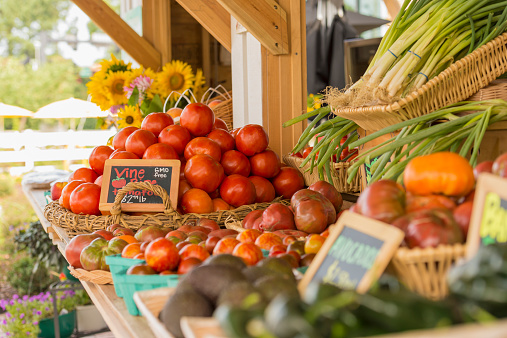
Head to the market with an open, curious mind—try new tastes, and connect with the people who produce your food. Enjoy the process of discovery—it’s as much about the experience as it is about what you buy.
1. Time it right
Arrive early, before things get too picked over. High-demand items like berries, corn, and fresh peas go quickly. If you can, avoid peak market hours: It’s tough to navigate the crowds, and produce has wilted by that time.
2. Survey first
Take a preliminary lap around the market to find out what’s popping—then make your shopping list. For big venues, visit the market’s website for a printable map to make finding vendors easier.
3. Exercise restraint, but plan for a splurge
Keep your head and buy only what you’ll use within a week. Buddy up and split bigger lots, like baskets of tomatoes or bunches of herbs, with a friend. Budget for the weekly staples, but save some cash for special purchases, like flowers or a jar of honey.
4. Sense the season
It’s usually better to wait a bit rather than to dig into the first fruit or vegetable of the moment. Let the season get under way for a week or so, and then go for it to get the best flavors and texture.
5. Chat up the farmer
Growers eat, sleep, and breathe their produce, so tap into their expertise. Cultivate that relationship: Visit regularly, learn names, and always be respectful—you’re likely to get invaluable shopping and prep advice, details about upcoming harvests, and special deals (but don’t try to haggle; prices are often set by consensus among the growers). With this kind of relationship, you can even call ahead for big orders.
6. Take meat for a test run before buying big
Select lesser cuts like bacon or sausages to try out a new meat vendor. Decide how you like the product before going in for a pricier whole roast or chops.
7. Taste for quality
Take advantage of samples to try something new or to gauge flavor, sweetness, and texture. Don’t see samples? Just ask—most vendors will happily oblige. Produce comes to market at its peak and is much more delicate than what you’ll find at the grocery store; offering tastes prevents customers from overhandling.
This article originally appeared on CookingLight.com.
More from CookingLight.com:
More Must-Reads from TIME
- Breaking Down the 2024 Election Calendar
- How Nayib Bukele’s ‘Iron Fist’ Has Transformed El Salvador
- What if Ultra-Processed Foods Aren’t as Bad as You Think?
- How Ukraine Beat Russia in the Battle of the Black Sea
- Long COVID Looks Different in Kids
- How Project 2025 Would Jeopardize Americans’ Health
- What a $129 Frying Pan Says About America’s Eating Habits
- The 32 Most Anticipated Books of Fall 2024
Contact us at letters@time.com